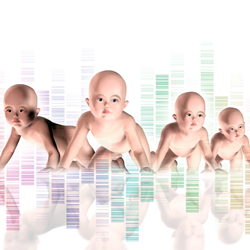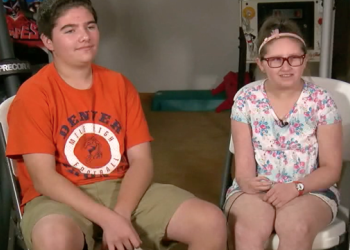You are here
Creating a Savior Child
When parents have a child with a serious illness, they face heart-wrenching treatment decisions. For those families with a child that requires a stem cell transplant, often there is the additional hurdle of finding a donor for the transplant. A successful transplant requires an HLA match between donor and recipient. However, the probability of finding a suitable match among family members is only 30% overall (1). Among siblings, the chances of having a perfect HLA match range from 13% to 51% in the United States, depending on patient age and ethnicity (2).
If members of the family do not match, the next options are to seek a match from the registries of unrelated adult donors, or from a registry of donated cord blood. But another factor parents need to consider, is that stem cell transplants have fewer complications and better survival rates with donors who are not just a match on the HLA types, but who are related to the patient (2).
Given these considerations, some parents explore the possibility of conceiving another child that will be an HLA match to their sick child. This is often called a “Savior Sibling”. When the savior child is born, its umbilical cord blood can be saved as a source of stem cells for the patient in need of a transplant.
Creating a savior child is not so simple as just getting pregnant and hoping for the best. The natural chances that another baby will be an exact HLA match to an older sibling are only 25%. Moreover, if the sick child has a hereditary disease, it is important to ensure that the next child does not inherit the genes that carry it.
Preimplantation Genetic Testing (PGT) refers to the genetic profiling of embryos. It is used to screen embryos for genetic diseases or chromosomal abnormalities. First the parents must conceive embryos through in-vitro fertilization (IVF) procedures. From each embryo, PGT takes a biopsy of only a few cells and conducts a genetic analysis. This analysis can search to exclude embryos carrying a genetic variant that causes a hereditary disease, and it can search to find embryos that are an HLA match to a sibling. Preimplantation genetic testing can be considered as a form of prenatal diagnosis (3).
Preimplantation genetic testing was first introduced in 1990 by selecting female embryos to prevent the birth of male patients affected with X-linked recessive disorders (4). The PGT allows diagnosis at three levels: chromosome abnormalities/aneuploidy (PGT-A), structural chromosomal abnormalities (PGT-SR), and single gene diagnosis and HLA typing (PGT-M).
Many fertility clinics are now offering PGT testing as a tool to improve IVF outcomes, to avoid the occurrence of known lethal or severely disabling inherited genetic diseases, and also as a way to avoid recurrent implantation or pregnancy failures. Preimplantation genetic testing offers parents a way to ensure their children will not be affected by a genetic disorder without facing the risk and consequences of terminating the pregnancy. All patients undergoing IVF are offered PGT-A, however PGT-SR and PGT-M are usually only offered to parents who are carriers of a genetic disease or structural chromosomal aberration.
The first PGT-HLA case was in the United States in 2001 and led to the birth of Adam Nash. Adam’s older sister Molly suffered from Fanconi Anemia, a recessive blood disorder that leads to a short life expectancy and is often associated with birth defects. Thanks to PGT, Adam was born free of Fanconi Anemia as well as a perfect HLA match for Molly. Adam’s umbilical cord blood was used for a successful transplant that cured Molly of the blood abnormalities of Fanconi Anemia (5). Eighteen years after this controversial transplant, both children are now happy young adults.
Following the success of the Adam Nash story, many other cases of PGT-HLA were reported in the media and the medical literature. Below are some examples:
In 2006, two European centers published their results from PGT-HLA typing procedures performed between 2001 and 2006. They reported that HLA diagnosis could be assured in over 90% of the embryos. The HLA program at both centers resulted in the birth of 51 babies and 10 successful stem cell transplantations. The primary reason that parents sought HLA typing was leukemia, and for PGT- HLA the primary indications were the hereditary blood disorders sickle cell anemia and β-thalassemia (6).
In 2008, the first successful bone marrow transplantation was performed for X-linked chronic granulomatous disease by using preimplantation female gender typing and HLA matching (7).
In 2010, the first UK case of a successful PGT-HLA savior sibling for Fanconi anemia was reported (8), followed by the report of the first “double hope” PGT-HLA child born in 2011 in France (9).
In 2013, doctors in Bulgaria reported their first case of a successful stem cell transplant for β-thalassemia using the cord blood of a sibling conceived using PGT-HLA (10).
In 2014, New Zealand published guidelines that granted permission to create savior sibling for a sick child with sickle cell anemia (11).
In 2018, the European Society of Human Reproduction and Embryology (ESHRE) published data from 15 years of PGT-HLA practice at 14 different centers. A total of 136 HLA matched babies were born, and stem cell transplants were performed in 57 cases. There were no complications reported in 77.3% of the transplants (12).
Despite the promising results and success stories, this technology raises ethical questions. The main moral argument against PGT-HLA is the fear that the donor child will be treated as a commodity, with the ensuing physical and emotional implications for the child. This is the slippery slope of creating so-called "designer babies".
The counterarguments in favor of PGT to create stem cell donors are that the burdens of cord blood and bone marrow procedures are minimal for the donor. Also, current studies indicate that embryo biopsy does not increase the incidence of major malformations in the resulting children, compared to children born after IVF or intracytoplasmic sperm injection (ICSI). (13).
To avoid arguments about slippery slopes, clear guidelines for PGT applications should be put in place. For this reason, some countries will only allow the use of preimplantation HLA typing when it is combined with PGT. If the family is already conducting a PGT to select an embryo that is not affected by a genetic disease, they are allowed to combine it with HLA typing to find a match for stem cell transplantation.
It is generally agreed by practitioners in the field that parents must meet the following criteria to be eligible for PGT-HLA procedures:
- Diseases eligible for PGT diagnosis must be lethal or severe, there must be a known genetic mutation associated with the disease (or the disease is X-linked), and the disease must potentially benefit from stem cell transplantation (14).
- Eligible diseases must also progress slowly enough for this treatment approach to be reasonable. From the start of IVF and PGT to the time that an elective stem cell transplant can be performed is a span of at least 10 months.
- Maternal age should preferably be below 38 years for optimal oocyte retrieval (7).
- Psychological counseling is mandatory throughout the process. Parents should be informed of all medical aspects of this procedure, their success rates, complications, and the risks.
Science and technology advance at an incredibly fast pace. Currently there is a significant gap between the biotechnology advancements in prenatal testing versus the necessary legal and ethical framework. It is imperative that legal and ethical standards be set for the benefit of both the families and professionals involved in the creation of savior children.
References
- Ballen K. Update on umbilical cord blood transplantation. F1000Research. 2017; 6:1556.
- Besse K, Maiers M, Confer D, Albrecht M. On Modeling Human Leukocyte Antigen–Identical Sibling Match Probability for Allogeneic Hematopoietic Cell Transplantation: Estimating the Need for an Unrelated Donor Source. Biol Blood Marrow Transplant. 2016; 22(3):410-417.
- Chen H-F et al. Preimplantation genetic diagnosis and screening: Current status and future challenges: J Formosan Med Assoc. 2018; 117(2):94-100.
- Verlinsky Y et al. Preimplantation diagnosis for Fanconi anemia combined with HLA matching. JAMA 2001; 285(24):3130-3133.
- Grewal SS et al. Successful hematopoietic stem cell transplantation for Fanconi anemia from an unaffected HLA-genotype-identical sibling selected using preimplantation genetic diagnosis. Blood. 2004; 103(3):1147-1151.
- Van de Velde H et al. The experience of two European preimplantation genetic diagnosis centres on human leukocyte antigen typing. Human Reproduction. 2009; 24(3):732-740.
- Reichenbach J et al. First successful bone marrow transplantation for X-linked chronic granulomatous disease by using preimplantation female gender typing and HLA matching. Pediatrics. 2008; 122(3):e778–e782.
- Walsh F. First successful saviour sibling treatment for UK. BBC News. 2010;
- Lamazou F et al. Preimplantation diagnosis with HLA typing: birth of the first double hope child in France. J Gynecol Obstet Biol Reprod. 2011; 40(7):682-686.
- Milachich T et al. Birth of a healthy infant after preimplantation genetic diagnosis by sequential blastomere and trophectoderm biopsy for β-thalassemia and HLA genotyping. Eur J Obstet Gynecol Reprod Biol. 2013; 169(2):261-267.
- New Zealand Government. Advisory Committee on Assisted Reproductive Technology (ACART). Guidelines on Preimplantation Genetic Diagnosis with Human Leucocyte Antigen Tissue Typing. 2014;
- Kakourou G et al. The clinical utility of PGD with HLA matching: a collaborative multi-centre ESHRE study. Human Reproduction. 2018; 33(3):520-530.
- Heijligers M et al. Perinatal follow-up of children born after preimplantation genetic diagnosis between 1995 and 2014. J Assist Reprod Genet. 2018; 35(11):1995-2002.
- Devolder K. Preimplantation HLA typing: having children to save our loved ones. J Med Ethics. 2005; 31(10):582–586.



 Background
Background  Adam and Molly Nash at ages 17 and 23 years old. Coverage by ABC News
Adam and Molly Nash at ages 17 and 23 years old. Coverage by ABC News 